Related Research Articles

The Toyota A Series engines are a family of inline-four internal combustion engines with displacement from 1.3 L to 1.8 L produced by Toyota Motor Corporation. The series has cast iron engine blocks and aluminum cylinder heads. To make the engine as short as possible, the cylinders are siamesed.

Mazda has a long history of building its own diesel engines, with the exception of a few units that were built under license.
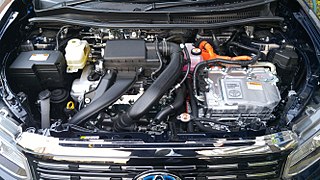
The Toyota NZ engine family is a straight-4 piston engine series. The 1NZ series uses aluminum engine blocks and DOHC cylinder heads. It also uses sequential fuel injection, and has 4 valves per cylinder with VVT-i.
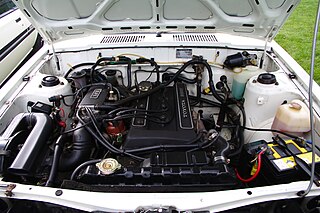
The Toyota T series is a family of inline-4 automobile engines manufactured by Toyota beginning in 1970 and ending in 1985. It started as a pushrod overhead valve (OHV) design and later performance oriented twin cam (DOHC) variants were added to the lineup. Toyota had built its solid reputation on the reliability of these engines.

The Toyota Motor Corporation G-family engine is a family of straight-6 piston engines produced from 1979 to 2008. It is notable in that only a single displacement, 2.0 L (1,988 cc), was produced in this series. Initially belt-driven OHC non-interference engines, multivalve DOHC and variable valve timing were added later during the production run. The 1G-GEU was Toyota's first mass produced four-valve twincam engine. A prototype version of the 1G-GEU called the LASREα–X, featuring twin-turbos, variable valve timing and intake as well as variable displacement, was fitted to the Toyota FX-1 show car at the 1983 Tokyo Motor Show. It showcased a number of technologies which were later to become commonplace.
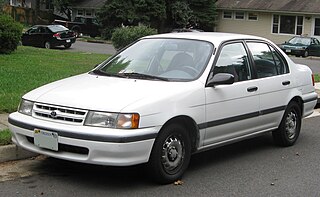
The Toyota Tercel is a subcompact car manufactured by Toyota from 1978 until 1999 across five generations, in five body configurations sized between the Corolla and the Starlet. Manufactured at the Takaoka plant in Toyota City, Japan, and sharing its platform with the Cynos and the Starlet, the Tercel was marketed variously as the Toyota Corolla II — sold at Toyota Japanese dealerships called Toyota Corolla Stores — and was replaced by the Platz in 1999. It was also known as the Toyota Corsa and sold at Toyopet Store locations. Starting with the second generation, the Tercel dealership network was changed to Vista Store, as its badge engineered sibling, the Corolla II, was exclusive to Corolla Store locations.

The Toyota E engine family is a straight-four piston engine series, and uses timing belts rather than chains. The E engines were the first multi-valve engines from Toyota designed with economy, practicality and everyday use in mind. Like many other Toyota engines from the era, the E engine series features a cast iron block, along with an aluminium cylinder head. E engines are lighter than earlier Toyota engines, due to the hollow crankshaft, thinned casting of the cylinder block, and several other reductions in auxiliaries as well as in the engine itself. Carbureted versions include a newly designed, variable-venturi carburetor. All of these changes improved economy and emissions. The members of the E engine family, range from 1.0 L to 1.5 L. The E family supplanted the K engines in most applications. A large number of parts in the E engine series are interchangeable between each other.

The Toyota KR engine family is a straight-3 piston engine, designed by Daihatsu, a subsidiary of Toyota. The 1KR series uses aluminium engine blocks and chain driven DOHC cylinder heads. It uses multi-point fuel injection, and has 4 valves per cylinder. Some versions have VVT-i variable valve timing. The engine is exceptionally light: 69 kg (152 lb) with all ancillaries. This is due to the nature of the applications and weight of city cars.

The DLD is the name for an automobile engine family – a group of compact inline-four Diesel engines, involving development by Ford of Britain and/or PSA Group, and also Mazda where it is called the MZ-CD or CiTD. The Ford of Britain/PSA and joint-venture for the production of the DLD/DV was announced in September 1998. Half of the total engine count are produced at Ford of Britain's main plant at Dagenham, England and at Ford's Chennai plant in India, the other half at PSA's Trémery plant in France.

The Toyota KD engine series is a diesel engine produced by Toyota which appeared in 2000.

The ZR engine is a family of straight-four 16-valve all-aluminum and water cooled gasoline engines with a die-cast aluminum block and variable valve timing developed by Toyota Motor Corporation, produced from 2007. Engines displace from 1.6 to 2.0 liters. Most engines in this family are equipped with Toyota's dual VVT-i technology that optimizes both intake and exhaust valve timing. This engine family is also the first to use Toyota's Valvematic system, first appearing on the Noah and Voxy in 2007 and then the European Avensis in 2009.
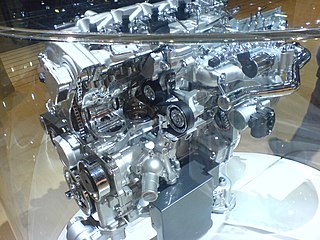
The Toyota AD engine family is a series of 16 valve DOHC inline-4 turbo diesel engines with electronic common rail direct injection using an aluminium cylinder head and an aluminium cylinder block with cast iron liners derived from the petrol Toyota AZ engine. The AD engine is offered in 2.0 and 2.2 liter versions. These engines are produced mainly for Europe, but few are exported to other areas such as India or New Zealand.
The ToyotaC engine family was a series of inline-4 diesel engines. There were two earlier generations of an engine Toyota named as the "Type C". The first generation was introduced in 1940 as a modification of the Type A engine. This first "Type C" was installed in the Toyota AE. The second generation was the first diesel engine at 1500cc used in the CS20 series 1959 Toyota Crown in October 1959. Japanese market vehicles with diesel engines were exclusive to Toyota Japan dealerships called Toyota Diesel Shop locations from 1979 until the dealership was cancelled in 1988.
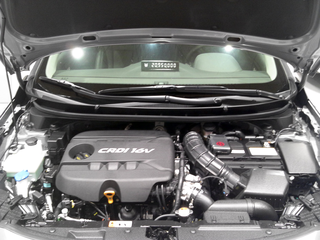
The Hyundai U engine is a series of three or four-cylinder diesel engines made for automotive applications by the Hyundai Kia Automotive Group. The U series of engines includes the smallest automotive diesel engines produced by Hyundai.

The Toyota NR engine family is a series of small inline-four piston engines designed and manufactured by Toyota, with capacities between 1.2 and 1.5 litres.
The Toyota CD engine is a 2.0 L (1,995 cc) diesel engine used in the Toyota Corolla, RAV4, Avensis and other vehicles. It is a DOHC engine with a bore and stroke of 82.2 mm × 94 mm with 116 hp (87 kW). The higher-output CD Series engines have now largely been replaced by the AD engine while low output applications where replaced by the ND engine.
Skyactiv is a brand name for a series of automobile technologies developed by Mazda that increase fuel efficiency and engine output. The initial announcement of the Skyactiv technologies included new engines, transmissions, body, and chassis, which appeared in Mazda products from 2011 onwards.

The Toyota GD engine series is a diesel engine produced by Toyota which appeared in 2015. It replaced the Toyota KD engine series as a diesel engine series mainly oriented to body-on-frame vehicles. The GD engine featured Economy with Superior Thermal Efficient Combustion (ESTEC) technology. Toyota claims they have a maximum thermal efficiency of 44 percent, "top class" at the time of introduction.
References
- 1 2 3 4 "The Toyota Yaris (revised first generation)" (PDF) (Press release). Toyota Press Office UK. 2003. Archived (PDF) from the original on 2022-10-31.
- 1 2 "Piccolo genio poco gasolio". Quattroruote. 2002-03-27. Archived from the original on 2014-02-22.
- ↑ "Toyota India | Official Toyota Platinum Etios site". www.toyotabharat.com. Retrieved 2018-01-31.
- ↑ "Toyota India | Official Toyota Corolla Altis site". www.toyotabharat.com. Retrieved 2018-01-31.
- ↑ "Toyota Yaris 1.4 D4-D Linea Luna - 3-doors, hatchback". Archived from the original on 2015-09-23.
- 1 2 3 4 2009 Toyota Yaris: Less Is So Much More – Toyota Media Site
- ↑ "carfolio website data".
- ↑ "Toyota Motoe Corporation Global Website | 75 Years of Toyota | General Status of Plants in Japan | Kamigo Plant". www.toyota-global.com. Retrieved 2018-01-31.